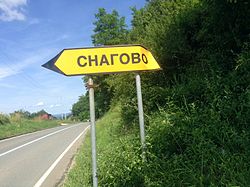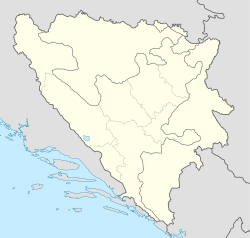
Srebrenica is a town and municipality located in the easternmost part of Republika Srpska, an entity of Bosnia and Herzegovina. It is a small mountain town, with its main industry being salt mining and a nearby spa. As of 2013, the town has a population of 2,607 inhabitants, while the municipality has 13,409 inhabitants.

Naser Orić is a former Bosnian military officer who commanded Army of the Republic of Bosnia and Herzegovina (ARBiH) forces in the Srebrenica enclave in eastern Bosnia surrounded by Bosnian Serb forces, during the Bosnian War.

The Bosnian War was an international armed conflict that took place in Bosnia and Herzegovina between 1992 and 1995. The war is commonly seen as having started on 6 April 1992, following a number of earlier violent incidents. The war ended on 14 December 1995. The main belligerents were the forces of the Republic of Bosnia and Herzegovina and those of Herzeg-Bosnia and Republika Srpska, proto-states led and supplied by Croatia and Serbia, respectively.

The Srebrenica massacre, also known as the Srebrenica genocide, was the July 1995 genocide of more than 8,000 Bosniak Muslim men and boys in and around the town of Srebrenica, during the Bosnian War.

The Bosnian genocide refers to either the Srebrenica massacre or the wider crimes against humanity and ethnic cleansing campaign throughout areas controlled by the Army of Republika Srpska (VRS) during the Bosnian War of 1992–1995. The events in Srebrenica in 1995 included the killing of more than 8,000 Bosniak men and boys, as well as the mass expulsion of another 25,000–30,000 Bosniak civilians by VRS units under the command of General Ratko Mladić.

The Republika Srpska was a self-proclaimed proto-state in Southeastern Europe under the control of the Army of Republika Srpska during the Bosnian War. It claimed to be a sovereign state, though this claim was not recognized by the Bosnian government, the United Nations, or any other recognized state. For the first few months of its existence, it was known as the Serbian Republic of Bosnia and Herzegovina.

Žepa is a village located in the municipality of Rogatica, Republika Srpska, Bosnia and Herzegovina. As of 2013 census, it has a population of 133 inhabitants. It is situated northeast of Rogatica itself on the banks of short river with a same name, the Žepa river, which flows into the Drina river nearby, in a valley between the mountains Javor and Devetak.

The Srebrenica Genocide Memorial, officially known as the Srebrenica–Potočari Memorial and Cemetery for the Victims of the 1995 Genocide, is the memorial-cemetery complex in Srebrenica set up to honour the victims of the 1995 Srebrenica massacre. The victims—at least 8,372 of them—were mainly males, mostly Muslim Bosniaks and some Catholic Croats.
The Korićani Cliffs massacre was the mass murder of more than 200 Bosniak and Croat men on 21 August 1992, during the Bosnian War, at the Korićani Cliffs on Mount Vlašić in central Bosnia and Herzegovina.

The Višegrad massacres were acts of mass murder committed against the Bosniak civilian population of the town and municipality of Višegrad during the ethnic cleansing of eastern Bosnia by Serb police and military forces during the spring and summer of 1992, at the start of the Bosnian War.

The Siege of Srebrenica was a three-year siege of the town of Srebrenica in eastern Bosnia and Herzegovina which lasted from April 1992 to July 1995 during the Bosnian War. Initially assaulted by the Yugoslav People's Army (JNA) and the Serbian Volunteer Guard (SDG), the town was encircled by the Army of Republika Srpska (VRS) in May 1992, starting a brutal siege which was to last for the majority of the Bosnian War. In June 1995, the commander of the Army of the Republic of Bosnia and Herzegovina (ARBiH) in the enclave, Naser Orić, left Srebrenica and fled to the town of Tuzla. He was subsequently replaced by his deputy, Major Ramiz Bećirović.
The Kravica attack was an attack on the Bosnian Serb village of Kravica by the Army of the Republic of Bosnia and Herzegovina (ARBiH) from the Srebrenica enclave on Orthodox Christmas Day, 7 January 1993. During the Bosnian War, the Srebrenica enclave was besieged by the Serb forces who rarely allowed humanitarian aid to enter the area, creating hunger and lack of medicine among the Srebrenica inhabitants. It is alleged that the ARBiH attacked, among other objectives, in order to find food, but also to acquire weapons, ammunition and military equipment. The attack was organized to coincide with the Serbian Orthodox Christmas, leaving the Serbs unprepared for any attack.
The Kravica massacre was one of the mass executions of Bosniaks by the Army of Republika Srpska during the Srebrenica massacre. It was committed on January 07, 1993. It is estimated that between 1,000 and 1,500 men were killed.

Donji Potočari is a village located in the municipality of Srebrenica, Republika Srpska, Bosnia and Herzegovina. As of 2013 census, the village has a population of 705 inhabitants.
Liplje is a mountain village located in the municipality of Zvornik, Bosnia and Herzegovina, neighboring Snagovo. Within Liplje there are 14 settlements: Bajrići, Bećirovići, Čamlija, Hadžići, Husići, Jašići, Jošanica, Kadrići, Korin Brijeg, Liplje, Salihovići, Samari, Sultanovići and Velja Glava.

The Snagovo massacre refers to the mass killing of 36 Bosnian Muslim civilians by Serbs on 29 April 1992 in the village Snagovo, located in the municipality of Zvornik, Bosnia and Herzegovina. The massacre occurred at the start of the Bosnian War.
The Bijeli Potok massacre refers to the mass killing of 684 Bosniak civilians by Serbs on 1 June 1992 in the settlement Bijeli Potok within the village Đulići, located in the municipality of Zvornik, Bosnia and Herzegovina. About 684 Bosniak men and boys, from the multiple villages around Zvornik, were separated from their families by Serb forces, and slaughtered within a week at Bijeli Potok and their bodies hidden in mass graves throughout the Drina Valley.
The Crni Vrh mass grave, discovered in 2003, is among the largest mass graves found in Bosnia and Herzegovina after the Bosnian War of the 1990s. It was discovered on the mountain Crni Vrh, and contained the remains of 629 Bosniak victims, killed by Serb forces in the villages surrounding Zvornik in 1992 and Srebrenica in 1995. The International Commission on Missing Persons said that the victims had originally been buried in other locations, but were reburied in the remote grave on Crni Vrh after the war in an effort to conceal the crimes.

Bosnian genocide denial is an act of denying or asserting that the systematic Bosnian genocide against the Bosniak Muslim population of Bosnia and Herzegovina, as planned and perpetrated in line with official and academic narratives defined and expressed by part of the Serb intelligentsia and academia, political and military establishment, did not occur, or at least it did not occur in the manner or to the extent that has been established by the International Criminal Tribunal for the former Yugoslavia (ICTY) and the International Court of Justice (ICJ) through its proceedings and judgments, and described by subsequent comprehensive scholarship.
Hatidža Mehmedović was a Bosnian human rights activist, survivor of the Srebrenica massacre, and founder of the Mothers of Srebrenica, an association of women whose relatives were killed in the July 1995 massacre in Srebrenica. Following the massacre of more than 8,000 Muslim Bosniak men and boys, including her husband and two sons, Mehmedović became a vocal advocate for bringing the perpetrators of the Srebrenica massacre to justice.













